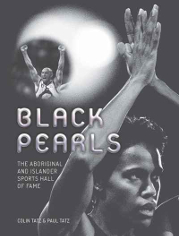Black Pearls
 Thursday, July 12, 2018 at 9:00AM
Thursday, July 12, 2018 at 9:00AM 
With special guests:
-
Colin & Paul Tatz
… in conversation with Bill Kable
Black Pearls: The Aboriginal and Islander Sports Hall of Fame is a celebratory book about the earth shattering sporting performances of our Aboriginal and Islander Australians since the arrival of the white man in 1788. The launch of this book joins the other celebrations around the country for NAIDOC Week 2018.
This handsome work is presented by the Aboriginal Studies Press. As our guest Colin Tatz explains, the book is also a Hall of Fame that unlike bricks and mortar halls can be on display in our own homes and carried around with us.
With its beautiful pictures and stories about its 276 members covering 36 sports this is a project that began in the Bi-Centenary year of 1988 after Colin spoke to some communities about the absence of recognition for these sports stars.
The book is however not just a catalogue of sporting triumphs. It tells how the Aboriginal and Islander peoples had to overcome enormous obstacles in order to be accepted as the champions they are. It is important to see the performances in that context in order to really appreciate the scale of the achievements.
Black Pearls explores what constitutes an Aboriginal or Islander person. Until 1969 the answer was in a mathematical calculation of blood lines. Then in 1969 the Federal Minister for Aboriginal Affairs, W. C. Wentworth introduced self-identification where if a person identified as Aboriginal or Islander and that person was recognised by others in the Aboriginal or Islander communities then this was sufficient. It was hoped that this would put an end to the demeaning categorisation. Unfortunately there are abiding issues that we need to continue working to overcome.
The selection panel for the Hall of Fame included some well-known Aboriginal and Islander sports people and there were strict selection criteria in order to be admitted. The sporting achievement required was representation of Australia or a national or international record or title. It would also include notable “firsts” and medal winners. There was a further criterion established in that the person had to have made a contribution to ATSIS identity. And sentiment was to play no part.
To find the sporting achievements required a lot of detective work and research is continuing. Not many people know that John Cutts the jockey on Archer, the horse who won the first Melbourne Cup in 1861, was most likely an Aborigine. The first Aboriginal sportsperson discovered by Colin and Paul was a cricketer named Shiney or Shinal. A very sad story that has to be read to be believed.
This book is an invaluable work for research into Australia’s history and is also wonderful to dip into for getting some light on the heroes we have grown up with or heard about forever. We dip into it ourselves in this enlightening program with family input from Colin Tatz and his son Paul Tatz.
Colin Tatz
Colin Tatz has a PhD in Aboriginal Administration and was Professor of Politics at the University of New England and Macquarie University. He is currently a Visiting Professor of Politics at the Australian National University and is the author of 25 books including Obstacle Race: Aborigines in Sport.
Paul Tatz
Paul Tatz studied as a professional photographer at the Sydney School of Arts. He is the co-author of two books with Colin Tatz: Black Diamonds and Black Gold: The Aboriginal and Islander Sports Hall of Fame.
Song selection by Colin: We Three (My Echo My Shadow and Me) by The Ink Spots
Song selection by Paul: Galatea’s Guitar by Gabo Szabo

